Leading with Compassion: The Future of Hospitality Careers
On April 22, Valley Vision hosted a virtual regional advisory centered on the adaptations of the Hospitality, Culinary, and Tourism industry through the pandemic. While the sector continues to represent employment below pre-pandemic employment levels, the Greater Sacramento region has recovered 40% of jobs originally lost in this sector. Nationally, wages have increased by almost $3.00 per hour to an average of $19.68.

The event featured keynote speaker Marc Sapoznik, President and CEO of Rancho Cordova Travel & Tourism, labor market information from Aaron Wilcher, Research Director of the Center of Excellence, and an industry panel including:
- Shelly Moranville, General Manager, Residence Inn, Marriott
- Jonathan Modrow, Owner, Bottle & Barlow
- Brittany Claypool, Brand Strategist, Oak Park Brewing
- Andrew Moret, Director of Culinary, Oakmont Management Group
- Marc Sapoznik, President and CEO, Rancho Cordova Travel & Tourism
During the event, panelists described changes and innovations within their companies including moving to fast-casual service with to-go options, producing canned beverages, advancing the adoption of technology, partnering to recruit for talent shortages, and turning a portion of their establishment into community rental space. As Shelly Moranville from Residence Inn, Marriott put it, “We’ve changed the way we do everything.”
“We’ve changed the way we do everything.”
Shelly Moranville
The labor market information presented highlighted a need to fill management positions including General and Operations Managers, Food Service Managers, Personal Service Managers, Entertainment and Recreation Managers, Chefs, and Head Cooks. These positions also offer the highest earnings potential within the industry. The panel agreed on the need for training for management positions highlighting the burnout of their leadership teams from the toll of the pandemic.
Several panelists acknowledged investing more in their current workforce than in the past, including establishing “paths to success” for entry-level employees to gain the skills and experience necessary to prepare them for higher roles. Andrew Moret of Oakmont Management Group discussed their Executive Chef Training Program in development as an example of this upward mobility framework. The panel agreed that learning the career goals of individual team members and helping them achieve them was a best practice. This was just one example of a change to a more employee-centered culture including increased flexibility and accommodation of individual employee needs and schedules. Employers reported altering the availability requirements for existing workers and incoming hires to improve employee retention. As Ms. Moranville stated, “[We] have to be much more flexible to the needs of the associates, and I don’t think that’s a bad thing. As employers, [the pandemic] has forced us to shift and be more understanding of what’s going on in someone’s life.”
The panel agreed the need for high-quality soft skills or essential skills was desperately needed in employment candidates including communication, teamwork, leadership/initiative, cultural and self-awareness, and creativity/adaptability. Jonathan Modrow of Bottle & Barlow stressed the need for an “instinct for care and collaboration”. Mr. Moret closed us with critical words for today’s culture stating the need to lead with “compassion for guests, each other, and yourself” is greatly needed in today’s hospitality workforce.
Valley Vision’s employer and industry advisories are funded by Los Rios Community College District with Strong Workforce Program funds. Additionally, the Capital Region’s four workforce boards co-sponsor the advisories; SETA/Sacramento Works, Golden Sierra JTA, YoloWorks, and North Central Counties Consortium.
To keep up with Valley Vision’s work to advance a future-ready workforce in the Sacramento region, subscribe to our 21st Century Workforce email newsletter!
Danielle Susa is a Valley Vision Project Associate supporting initiatives within the 21st Century Workforce impact area.
Renee John is the Director of Workforce Development managing initiatives within the 21st Century Workforce impact area.
Our Core Values in Action
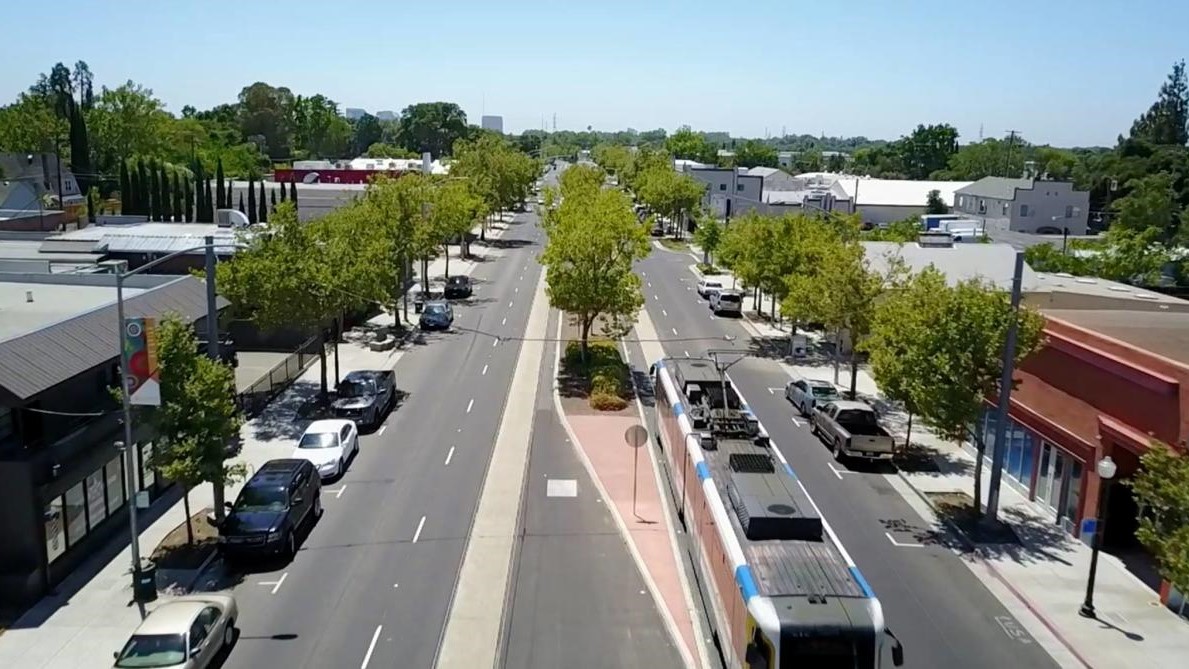
With our mission of creating livable communities by advancing social equity, environmental sustainability, and economic prosperity for the region, Valley Vision has been a constant and steady presence in the area for 28 years.
Our work has always been values-centered, although we haven’t always clearly expressed those values for ourselves or others. Over the past several months, our staff and Board took an exercised approach to tease out the fundamental ideals that drive our work and articulate who we are. We are proud to share:
- STEWARDSHIP: We exist to serve our communities to advance social equity, environmental sustainability, and economic prosperity.
- COLLABORATION: We value building genuine connections that honor our communities and partners.
- COURAGE: We are willing to do hard things.
- PASSION: We are energized by our work and our communities.
Values are only words on paper without commitments and practices that support them. The following depicts our intentions to live out these values.
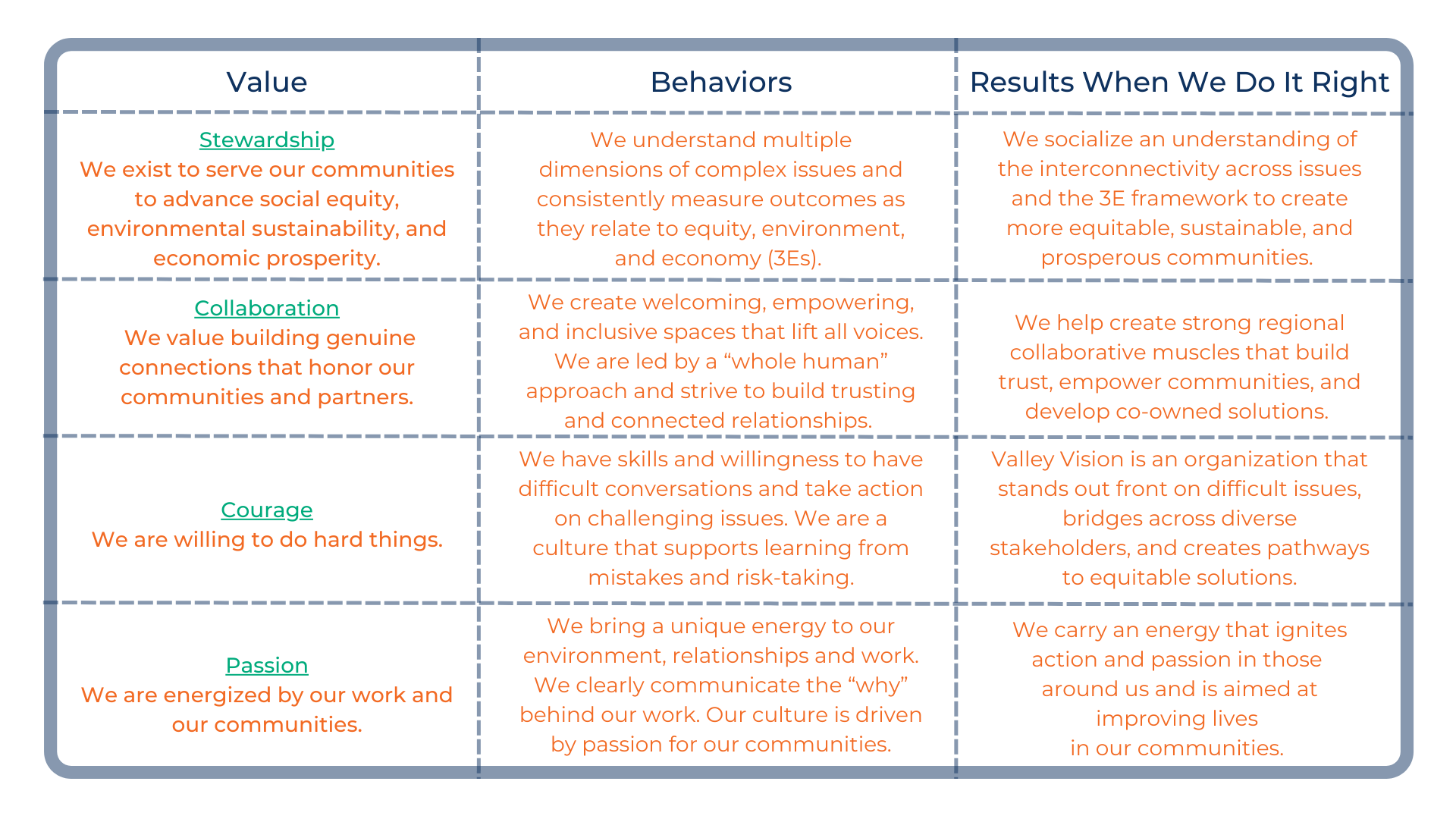
The values that we hold provide a foundation for the work we do and the way we do it. When we are supporting healthy food systems, developing equitable workforce pathways, or launching a new regional initiative for equitable and low carbon economic growth – these values should shine through. Our goal is to ensure that our values are apparent to all who work with us in the ways we engage and activate our work. We welcome your dialogue and feedback.
What are the values that anchor and guide you? Let’s support each other in activating values-driven leadership to foster equitable, sustainable, and prosperous communities.
To keep up with Valley Vision’s work to advance livability in the Sacramento region, subscribe to our Vantage Point email newsletter!
Evan Schmidt is Valley Vision’s Chief Executive Officer.
Highlighting Training Needs in Cybersecurity

Valley Vision serves a unique role as the workforce intermediary in the Capital Region’s training and development ecosystem. In this role, we work closely with the community colleges, workforce boards, community-based organizations, employers, industry partners, and local jurisdictions to improve our region’s responsiveness to the needs of both industry and the community. To that end, Valley Vision produces employer and industry advisories in occupational areas of growth and interest to inform education and training partners to address and respond to these needs to support our overall economy.
On March 31st, Valley Vision hosted an advisory on the growing demand for Cybersecurity occupations. The advisory included a keynote presentation by Nathaniel Le of the Federal Bureau of Investigation (FBI) and labor market information including job posting and skills analysis by Ebony Benzing, Research Manager of the Center of Excellence, as well as an industry panel discussion with the following representatives:
- Tania Webb, Managing Director of Deloitte
- Benjamin Troglia, Associate Director of Accenture
- Andrew Maroun, Director of Information Security of Golden 1 Credit Union
- David Bitter, Cybersecurity Manager of SMUD
During the advisory, panelists described a need for both generalists and specialists to meet their staffing needs. While specific technical skills are needed, the highest demand traits these employers revealed were a passion for the work and interpersonal skills, including written and verbal communication, to work well within teams and with external customers. Webb indicated understanding the “why” of the services employees are providing is essential and pre-eminent to thinking through how the technology solution helps meet that need, while Bitter indicated applicants who demonstrate an interest in the field beyond classwork, through clubs or competitions, are highly valued. Additionally, he noted the challenge for educators to keep up with the training needs of the industry due to technology evolving exponentially. He indicated and other panelists agreed, that there is more tendency to recruit generalists who can learn specialties on the job. “I don’t think it’s realistic to expect these students coming out of educational institutions to have that (specific) knowledge,” Bitter said.
While panelists indicated recruiting individuals with a Bachelor’s Degree (or higher) was common, most stated they are open to candidates who can demonstrate the experience, skills, and knowledge without a degree.
Panelists were asked about specific technical skills, degrees, and certifications to obtain entry-level employment in the field. While panelists indicated recruiting individuals with a Bachelor’s Degree (or higher) was common, most stated they are open to candidates who can demonstrate the experience, skills, and knowledge without a degree. Certifications were indicated as one way to differentiate while seeking employment, although practical real-world experience had as high or higher of a value. Specific certifications in demand include SAMs, CISP, and CompTIA Security+, which can elevate one candidate over another and demonstrate the candidate’s initiative to continue learning in their field. Specific technical skills in demand included Linux, Python, and Network Security.
When asked what advice would the panelists give to individuals trying to break into the Cyber Security field, networking, getting as much practical experience as possible, and staying up on the latest news in the security field were indicated as key. Maroun noted a particular challenge is the lack of diverse candidates entering the field which among other challenges limits the group’s creativity diverse backgrounds bring in developing solutions.
Join us for two additional upcoming advisories on the changing needs of Hospitality, Culinary, and Tourism on April 22nd and the expanding needs for Forestry Management Occupations on April 28th. Valley Vision’s full resource industry of advisories is available here.
Valley Vision’s employer and industry advisories are funded by Los Rios Community College District with Strong Workforce Program funds. Additionally, the Capital Region’s four workforce boards co-sponsor the advisories; SETA/Sacramento Works, Golden Sierra JTA, YoloWorks, and North Central Counties Consortium.
To keep up with Valley Vision’s work to advance a future-ready workforce in the Sacramento region, subscribe to our 21st Century Workforce email newsletter!
Nghia Nguyen is a Valley Vision Project Associate supporting initiatives within the 21st Century Workforce impact area.
Renee John is a Valley Vision Project Leader managing initiatives within the 21st Century Workforce impact area.
Digital Inclusion Coalition Expands with New Platform
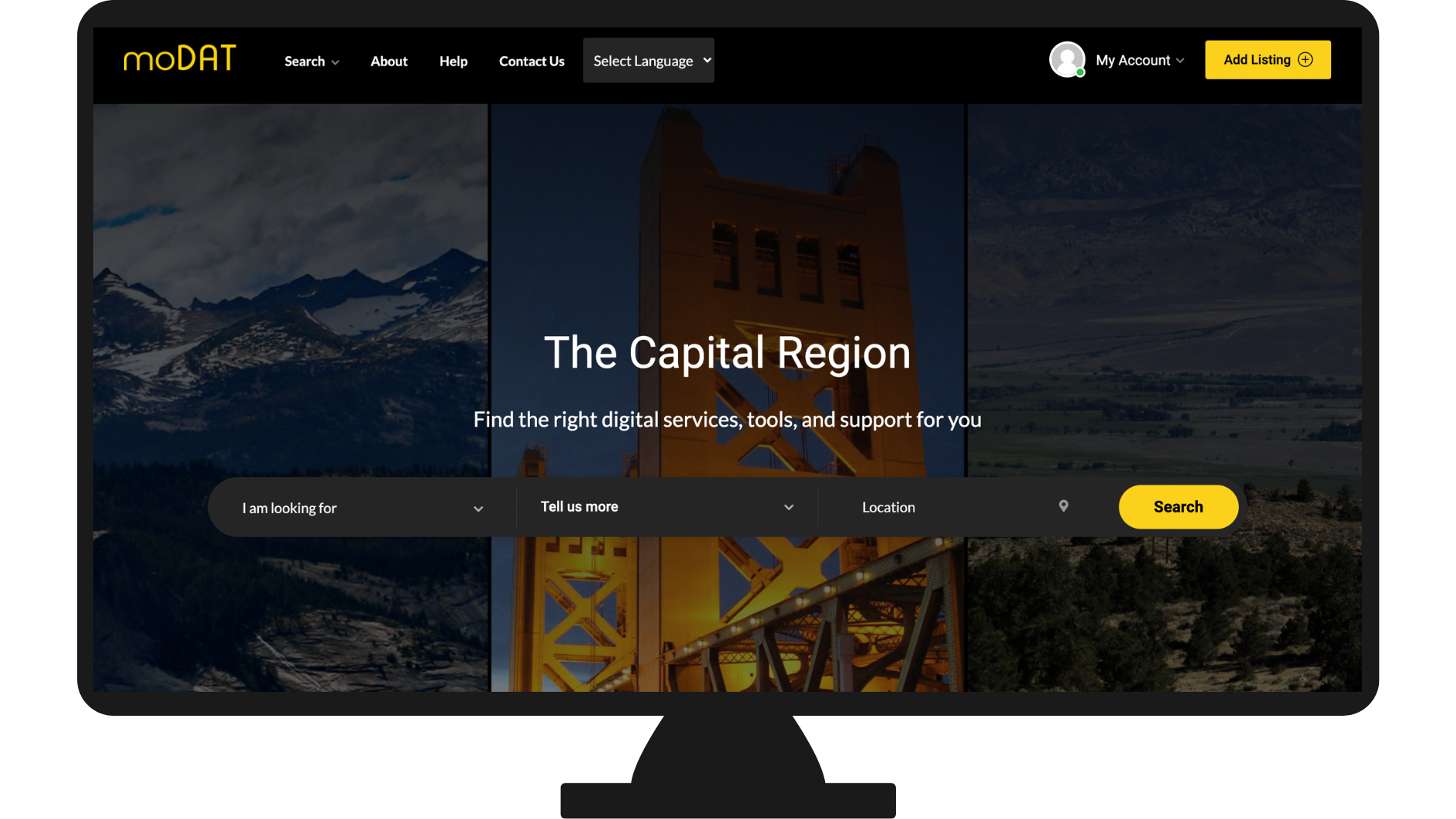
The last two years have proven the significance of digital inclusion to accessing opportunity and economic prosperity. Our nation is experiencing unprecedented investment, including the Affordable Connectivity Program through the Federal Communications Commission (FCC) – a $14.2 billion piece of the Infrastructure Investment and Jobs act, and the biggest investment in broadband this country has ever seen. The Greater Sacramento region is well poised to garner and maximize investments in digital inclusion due in no small part to the dedicated contributions of the steering committee, working groups, and members of the Sacramento Coalition for Digital Inclusion (Coalition).
This effort started in the fall of 2018, inspired by a Brookings Institution report on the strengths and weaknesses of the Sacramento Capital region, and culminated in the formation of the Coalition. Over the years, the work of the Coalition has brought together partnerships, thought leaders, and collaborative investment to address the digital inclusion needs of our region especially during the heightened needs of the pandemic.
A Year of Impact
In the last year, the Coalition has hosted eight full Coalition meetings and over 25 working group meetings in three key areas; Broadband Access & Adoption, Hardware Devices, and Digital Literacy/Digital Skills to build a framework and key strategies including:
- Renaming, redesigning and taking over management of the Coalition website to provide easy access to resources and information
- Operationalizing a digital inclusion portal to provide easy access to free resources for community members and the organizations supporting them
New Name & Expanded Region
The Coalition recently changed its name to the Capital Region Coalition for Digital Inclusion, reflecting an expanded service area and regional approach to creating more opportunities for digital equity. This name change represents the expansion to serve a 9 county region supported by investment from the Capital Region’s four workforce boards, SMUD, AT & T and Union Bank, and magnifies opportunities to address both rural and urban digital equity barriers, and convene organizations from across the region to better inform, connect, and partner to promote community success.
New Digital Inclusion Portal Serving Nine Counties
Valley Vision is pleased to partner with mohuman, a non-profit connecting low-income communities with digital resources, to create the Capital Region Digital Inclusion Portal. Through this partnership, a streamlined platform has been created for the Capital Region, allowing community members and those serving them to easily search for resources – including free and low cost computers, internet services, digital skill building tools and training. Among other resources, the Digital Inclusion Portal connects individuals with training on Microsoft Office and Google Suite, as well as career search skills and more! The platform also allows organizations with digital inclusion resources to add their information to the Portal (after a review process) and claim their listings to provide additional description and detail.
Nishal Mohan, Founder of mohuman, describes the work of the Coalition and the impact of the Portal: “The Capital Region and their digital inclusion coalition have been doing a fantastic job of regional coordination to serve digitally un and underserved individuals and families. Now with a personalized and easy to use portal, all of their free or low-cost digital inclusion services and resources are available to the public in an easy to use, accessible, expandable, and sustainable platform so that more people can move towards equity faster, more effectively, and at scale. Congratulations to Valley Vision and partners on bringing a powerful tool with the people for the people of the Capital Region!”
The Coalition’s goal is for the Portal to serve as a centralized source for community members and organizations to find and upload resources for computing devices, internet connectivity, and digital skill building. We need your assistance to create an expansive and thorough network of listings and are calling digital inclusion advocates to aid us in the following ways:
- Share the portal with community members and organizations to utilize for easy access to digital resources
- Add listings through the portal or email nghia.nguyen@valleyvision.org with information on digital inclusion organizations, programs, or online services that need to be included
- If you work at or manage an organization that provides digital inclusion resources, claim your listing, and make it your own!
With your help and assistance, we will continue the momentum to improve digital inclusion for our Capital Region’s current and future digital citizens. To keep up with Valley Vision’s work to advance a future-ready workforce in the Sacramento region, subscribe to our 21st Century Workforce email newsletter!
Caitlin Blockus is a Valley Vision Project Manager supporting initiatives within the 21st Century Workforce impact area.
Yolo County’s YoloWorks! Launches Virtual Employment Center

Job attainment and security are more important than ever, but unpredictable COVID-19 regulations and a turbulent economy have proved it difficult for applicants to access the employment specialists and career services they need. Prior to the pandemic, YoloWorks!, under the Yolo County Health and Human Services Agency, was able to offer in-person career center support and counseling to Yolo County residents from its local offices. However, without a uniform method of providing real-time employment support virtually, the employment center needed to pivot to maintain the full extent of its workforce services.
To address this challenge, YoloWorks! Program Coordinator Erica Johnson developed and aided in the launch of the employment center’s first virtual career center platform. The Virtual Employment Center went live on November 16, enabling Yolo County residents to virtually receive career and vocational training services from employment specialists and case managers.
Making Career Help Available & Accessible
Open 8:00 AM – 4:00 PM Monday through Friday, the Virtual Employment Center (VEC) opens up a myriad of new connections between job seekers and employers. Offering these essential services virtually eliminates a multitude of barriers for new entries to the workforce, including maintaining personal health, reducing travel costs, and more. Training opportunities and the location of available jobs are just two examples of the many services offered by the VEC.
“This is exactly the type of support we want to provide the people of Yolo County.”
Erica Johnson, Yoloworks! Program Coordinator
“Supporting the needs of job seekers with our intelligent chatbot has revolutionized how citizens discover jobs in Yolo County,” said Erica Johnson, YoloWorks! Program Coordinator. “Job seekers can now schedule time with YoloWorks! employment specialists to locate relevant work anytime, anywhere, and have common questions answered quickly in their native language. This is exactly the type of support we want to provide the people of Yolo County.”
Digital Inclusion and the Community
The VEC is a platform that requires internet connectivity to fully utilize. Thus, this calls for adequate infrastructure in the community it serves. YoloWorks! has partnered with Google to provide the “Loan to Own” Chromebook Program for those who might not have access to the devices they need to be successful in this era of virtual integration. Successful completion of this program allows participants to permanently keep their Chromebooks, providing them with a computing device and the ability to earn a work-skills online certificate with digital badging. As of December of 2021, 180 of 250 Chromebooks have been distributed to Yolo County residents. 35 Yolo County residents have completed the program and now own these devices. And to ensure that the platform is accessible to as many communities as possible, Yolo County job seekers can utilize the portal’s chatbox in the region’s three most common languages—English, Spanish and Russian.
This partnership has also granted Yolo County’s YoloWorks! with 500 Google Career Certificates, which are available to Yolo County residents to apply for and receive for free. These certificates include credentials in areas like IT, Project Management, User Experience Design, and Data Analytics. They also provide interested participants with valuable skills such as interviewing tips and connections to 140+ companies that are a part of an employer consortium consisting of nationally-recognized organizations who are hiring for entry-level talent.
From Tragedy Comes Opportunity
With the rise of online outreach and virtual events comes a unique need for collaboration between employers and communities. The VEC constantly works with community partners to ensure that job opportunities are being announced with ample time for applicants to gain access to workstations or smartphones. Additionally, the portal itself promotes ease of access by giving patrons the ability to attach necessary documents (resumes, applications, etc.) and syncing with the account’s Google Calendar. From supplying required technology to providing a user-friendly interface, the VEC is already making waves in terms of reaching the people who would benefit the most from its services.
“The pandemic really shifted the way in which we think, work, and live,” Johnson said. “We wanted to put a service out there for folks that is always available, whether or not they want to come in person.”
To keep up with Valley Vision’s work to advance a future-ready workforce in the Sacramento region, subscribe to our 21st Century Workforce email newsletter!
Danielle Susa is a Valley Vision Project Associate supporting initiatives within the 21st Century Workforce impact area.
Renee John is a Valley Vision Project Leader managing initiatives within the 21st Century Workforce impact area.
Our Bright Future in 2022: Best Case Scenarios for the Sacramento Region

Valley Vision has a longstanding making “bold predictions for the new year.” This is my second new year as CEO in which I’ve held this responsibility and, I have to say, these years have not been at all predictable! 2021 did not go as anyone predicted, and 2022 has already gone sideways. So, what do I think we can expect for 2022? The unexpected – what else? Instead of dwelling on the uncertainties that we are all living with everyday, I’d like to envision our brightest future and best case scenarios for the Sacramento region in 2022. What can we achieve, even in the face of uncertain times?
Major Economic Recovery Dollars Invested in the Capital Region
State and federal government recovery and infrastructure programs are paving the way for historic investments in economic recovery, workforce, broadband, transportation, climate resilience, and more. With so many competitive grant processes, our region has the opportunity to advance major big picture initiatives and win the dollars to fund them. Our best case scenario: we rise to the challenge as a region and bring in transformative change ushering in equitable recovery for our region. Learn more about and get involved in Valley Vision’s effort to secure Community Economic Resilience Funds for our region as a start.
The Capital Region is a National Leader in Low Carbon Economy and Climate Resilience
Our region has some of the most ambitious emission reduction goals in the nation and the ingredients to make meaningful progress to foster clean innovation in advanced mobility, clean energy, electrification, and climate smart agriculture and overall climate adaptation. In our best case scenario, we advance ambitious and cohesive regional plans and initiatives that make our region more climate resilient and grow our innovative and vibrant clean economy. Check out economic goals identified in the Prosperity Strategy, SMUD’s ambitious 2030 Plan, the California Mobility Center, and SACOG’s Green Means Go initiative for a few examples of our regional commitment to a clean economy.
Sacramento Community Rallies to Address Homelessness
Our unhoused population has increased throughout the pandemic and divisions of how to address housing and homelessness have overtaken our ability to advance reasonable solutions. In our best case scenario: Public agencies, elected officials, civic organizations, service providers, advocates, and residents work together to implement new programming, effectively site new facilities, and meaningfully reduce the number of people who are living unhoused and on the streets. Learn more about the City of Sacramento’s Response Plan.
The Sacramento Region Closes the Digital Divide
There are significant dollars available this year to support the expansion of broadband infrastructure and digital inclusion, resulting in increased access to the Internet and opportunities to improve digital equity in communities throughout the region. In our best case scenario: we are able to capture those dollars; build our broadband infrastructure and address technology access; and create digital literacy and skills training for all who need it (in our best case scenario we win funding to support digital skills training through the Good Jobs Challenge). Learn more about the Infrastructure and Jobs Act and Valley Vision’s work on broadband access and managing the Sacramento Coalition to close the digital divide.
The Comeback of Downtown Sacramento
In 2019, downtown Sacramento was building on the momentum of the Golden 1 Center, breaking ground with Railyards development and the new SAFE Credit Union Convention Center, and more. Then – the pandemic hit. In our best case scenario: downtown picks up where it left off and then some – building on existing assets and embodying a vibrant and equitable pandemic recovery as the economic hub of our region. We envision workers returning to offices, enhanced public transit, a vibrant arts and culture scene, robust tourism and events, and safe, clean, and humane conditions for all. Check out the work of the Downtown Sacramento Partnership.
Are these headlines just pipe dreams? They are optimistic but I believe these scenarios are well within our grasp. We CAN usher in major investments this year and we DO have the ability to advance ambitious, innovative, equitable, and collaborative solutions. There are tremendous and historical investment opportunities, many expressed through the American Rescue Plan, the California 2022-2023 Budget proposal, the Jobs and Infrastructure Bill, and more. In addition to these programs, we have seen how communities have worked together to address the issues that most impact our communities throughout the pandemic, creating lightning-fast emergency response and adapting quickly to meet community needs. We can envision and enact a more equitable, sustainable, and prosperous future for our region. What will be required? A healthy civic culture and dialogue, the creation of shared agendas, a commitment to collaboration, and a willingness to learn and try new things.
Let 2022 be the year that – despite unpredictable conditions and continued challenges – our region finds ways to achieve our best case scenarios and create systems that are stronger, more adaptive, and more equitable, sustainable, and vibrant than ever before.
To keep up with Valley Vision’s work to advance livability in the Sacramento region, subscribe to our Vantage Point email newsletter!
Evan Schmidt is Valley Vision’s Chief Executive Officer.
New Project to Advance Yolo Food Hub

Developing the Yolo Food Hub will strengthen local farms, improve healthy food access, and provide a healthier food and farming ecosystem throughout the Greater Sacramento Region.
Valley Vision, on behalf of several local partners, has been awarded a grant from the US Department of Agriculture’s Local Food Promotion Program (LFPP) to support the establishment of the Yolo Food Hub.
Yolo Food Hub is a new facility that will aggregate, process, store, and distribute farm produce grown in Yolo County and surrounding areas on behalf of farmers in the area. Located in Esparto, Yolo Food Hub will expand food production and distribution channels in Yolo County and the Greater Sacramento Region, while at the same time improving healthy food access, stabilizing food markets, increasing employment and job training opportunities, and providing pandemic relief for farmers.
“Yolo Food Hub will help establish a more diverse and equitable food system – one that allows small and mid-size producers to sell fresh, nutritious food more affordably to schools, institutions and agencies, and to swiftly and efficiently donate oversupplies to lower-income and precariously-employed consumers.” – Dr. Maria McVarish, Esparto Community Member
Food hubs help connect farmers and food entrepreneurs with regional markets and institutional buyers, such as schools, hospitals, and food banks to access source-identified, locally grown products. The funds from this LFPP grant will be used to generate recommendations and a funding strategy to establish and sustain the new Yolo Food Hub. As part of the grant, farmers will receive training on how to reach institutional buyers, such as schools, hospitals, and restaurants, which will buy produce and goods from Yolo Food Hub.
Yolo Food Hub is one of the priority recommendations of the 2021 Sacramento Region Food System Action Plan-which is to build a network of food hubs to connect farmers to markets and increase institutional procurement. The Yolo Food Hub builds upon the 2014 food hub feasibility analysis conducted by SACOG through the Rural-Urban Connections Strategy (RUCS). Yolo Food Hub will support several other food hubs in the region, including Spork Food Hub and the Capay Valley Farm Shop.
“The creation of the Yolo Food Hub creates opportunities for farmers to connect to a broader array of local markets. The Spork Food Hub brings long-standing relationships with local school districts and the opportunity for students to receive the best quality produce the region can supply. By working together, we can strengthen the resiliency of the regional food system.” – Spork Food Hub
In addition, the new Yolo Food Hub will support a regional network of organizations by providing logistical support in aggregation, value-added processing, storage, and distribution services. By providing a variety of value-creating services, Yolo Food Hub will enable farmers to concentrate on growing food for targeted markets, strengthening operations, and scaling their operations.
“Expanding the market reach for agricultural producers and increasing the collaborative efforts of the Yolo Food Hub project partners is ripely timed and exciting. Capay Valley Farm Shop has been operating as a farmer and community-owned food hub since 2007 and is committed to bringing our expertise and enthusiasm to the Yolo Food Hub.” – Tracy Harding, Capay Valley Farm Shop
The cost of developing Yolo Food Hub is estimated at $10 million, $2 million of which has been committed by Yolo County for site acquisition. The Yolo Food Hub project team includes: New Season Community Development Corporation (NSCDC), Capay Valley Farm Shop (CVFS), Yolo Food Bank, Durst Organic Growers, Spork Food Hub, Hatamiya Group, Kitchen Table Advisors, and Valley Vision as the project manager.
For questions about Yolo Food Hub or how to get involved, please contact Grace Kaufman at Grace.Kaufman@ValleyVision.org.
What Are You Grateful for in 2021?
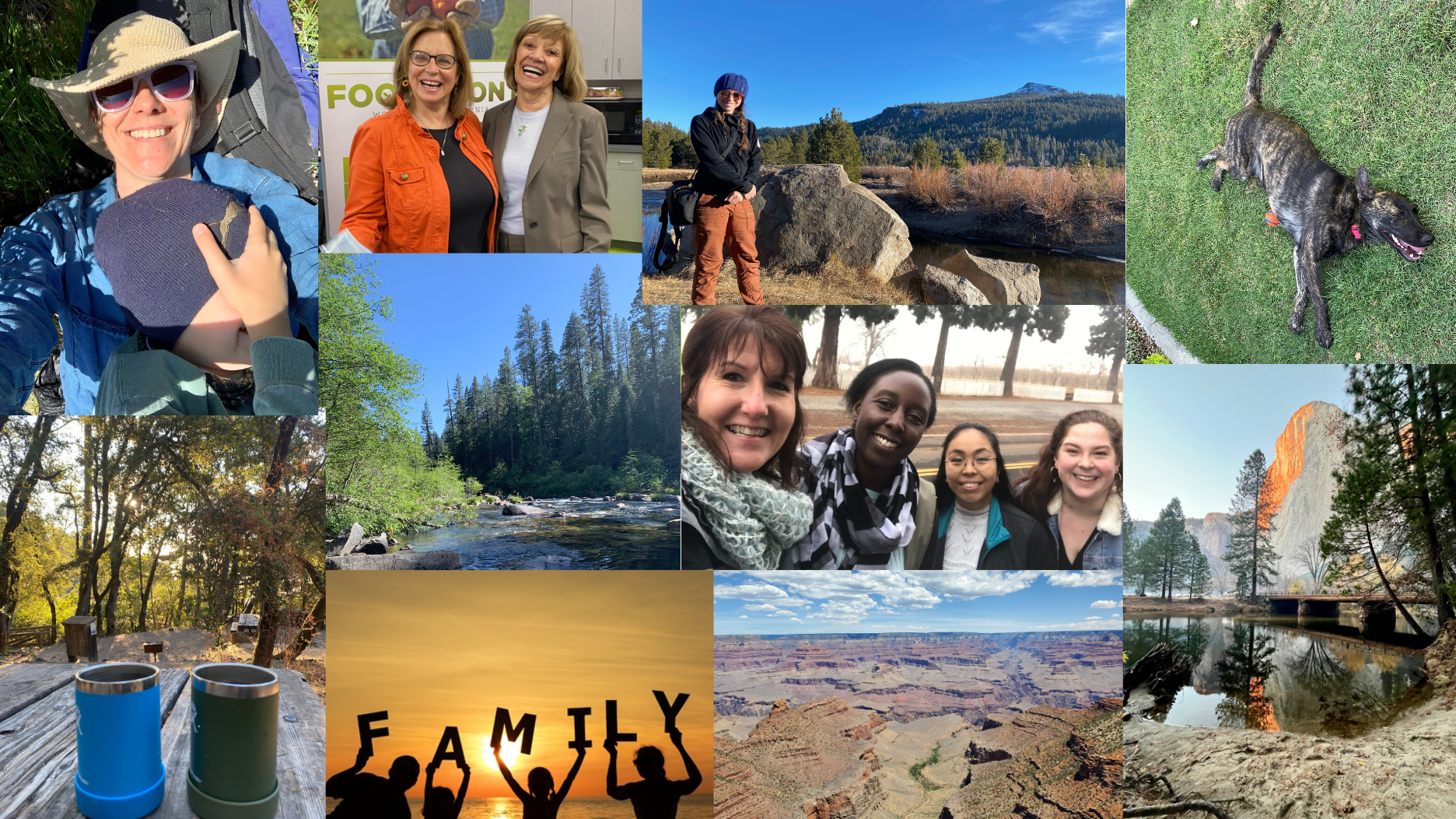
As each year comes to a close, Valley Vision staff reflect on what we have been grateful for over the past year. It’s an annual tradition, and we are excited to share our reflections with you. Thank you for continuing to support and collaborate with us!
Isa Avanceña: “I’m grateful for all the meals shared with family and friends, and time spent outdoors! I’m especially grateful for finally being reunited with my parents after more than two years of not being together! They arrive on Saturday from the Philippines.”
Renee John: “I am grateful for an amazing team dedicated to improving the lives of our region’s residents and for the collaborative efforts of a whole ecosystem of partners striving for a better future for all.”
Alan Lange: “I was grateful to read that charitable giving throughout the nation reached record levels in 2020. I am hopeful that the trend continued through this year. It is heartening to see individuals, businesses, and foundations step up when so many are in need. (And yes, I’m also grateful that the stock market helped buoy the charitable spirit!).”
Brittnii Johnson: “I’m grateful for all the simple things in life that I don’t take the time to appreciate. For example, family, friends that became family, the ability to care for myself, and having a place to live. I’m grateful to experience love in action.”
Grace Kaufman: “I’m grateful for experiences that provide me with a deeper appreciation of life and free me from distractions.”
Angelina Olweny: “I am grateful for good health and the opportunity to be part of a team and organization that is committed to making a positive difference in communities in the Sacramento region.”
Trish Kelly: “I’m very grateful that loved ones have made it safely through the year, that we are able to do work at Valley Vision that contributes to the community, and that the people we work with enrich our lives through rich and caring partnerships.”
Danielle Susa: “I am grateful for the people in my life who remind me why life is precious. I am also grateful for the simpler moments that remind me why life is beautiful.”
Evan Schmidt: “I’m grateful for the health and wellbeing of loved ones over the course of the year, the ability to do work that improves lives and communities, and moments of fun and levity with family and friends.”
Caitlin Blockus: “I am grateful to have adopted my sweet rescue dog in 2021, who has taught me many lessons in patience and understanding, and brought me so much joy and love. I am also grateful for COVID-19 vaccines and the ability to reconnect with my family.”
Natalie Garcia: “I’m grateful to have the opportunity to explore California’s diverse landscapes through van camping. And also grateful to have met some new awesome and authentic friends.”
Adrian Rehn: “I am grateful that myself and my loved ones have their health, and for being able to safely explore much of our country this past Summer.”
The Prosperity Partnership Helps Secure Millions for Inclusive Economic Impact for Greater Sacramento Region
Online webinars to be held starting November 18 for more information on access to funding.
SACRAMENTO, Calif. (November 3, 2021) – The Greater Sacramento region successfully scored two very significant wins via state of California legislative bills that will amount to millions in investment for inclusive economic development including: up to $38 million in funding for Green Means Go; and passage of the $600 million Community Economic Resilience Fund (CERF). Both of these victories were bolstered by the collective advocacy and leadership of The Prosperity Partnership which includes: Greater Sacramento Economic Council, Sacramento Asian Pacific Chamber of Commerce, Sacramento Metropolitan Chamber of Commerce, Sacramento Area Council of Governments (SACOG) and Valley Vision.
“These two victories at the state-level are critical towards the Greater Sacramento region’s recovery and economic resilience, as they not only deliver on real-time investment for jobs, business and infrastructure, but also demonstrate the collective value and impact we have when we work together,” stated The Prosperity Partnership in a joint statement.
Green Means Go is a multi-year pilot that implements the region’s Sustainable Communities Strategy. The pilot aims to lower greenhouse gas emissions and be a catalyst for economic development in the six-county Sacramento region by accelerating infill development. Green Means Go is led and implemented by SACOG, which recently was awarded over $38 million from the state to fund this one-of-a-kind state program. The funds will be critical to accelerate development within existing communities and reduce barriers to building more housing, increasing mobility options and accelerating EV deployment. Outreach and technical assistance will begin in January 2022 for funding requests with all funds to be used by June 30, 2026.
CERF is designed to build a more robust, sustainable, and equitable recovery across all sectors of California’s economy by supporting regional collaboratives in the planning and implementation of inclusive economic strategies towards both recovery and long-term resilience. CERF is funded by a $600 million one-time federal American Rescue Plan Act allocation. Developed in alignment with priorities identified through California Forward’s Roadmap to Shared Prosperity and supported with direct advocacy of The Prosperity Partnership, it will advance pivotal, place-based initiatives and high-road partnerships that reach into under-resourced neighborhoods, regional networks and rural communities; many of which are identified in the core strategies in the work by the partnership through Our Path Forward: The Prosperity Strategy.
An informational session on CERF and funding for organizations and local jurisdictions in Colusa, El Dorado, Placer, Sacramento, Sutter, Yolo and Yuba counties will be held virtually on Thursday, November 18 from 1:00 – 2:00 PM PT. For more information and to register, please visit valleyvision.org to register.
About Our Path Forward and The Prosperity Partnership
Our Path Forward: The Prosperity Strategy is a strategic framework and action plan for the six-county Greater Sacramento region that prioritizes the region’s core economic initiatives for a more prosperous, equitable and resilient economy. The framework was released in May 2020 as both an economic strategy as well as recovery plan. The framework parallels the goals and strategies of the region’s Comprehensive Economic Development Strategy (CEDS) and includes initiatives over the next five years that focus on a cluster-based economy, infrastructure investments and developing a sector-based workforce.
The Prosperity Strategy is the collective work of five regional organizations known as The Prosperity Partnership including Greater Sacramento Economic Council, Sacramento Asian Pacific Chamber of Commerce, Sacramento Metropolitan Chamber of Commerce, Sacramento Area Council of Governments and Valley Vision.
For updates and to learn more visit theprosperitystrategy.org.
Press Contact:
Traci Rockefeller Cusack at 916-213-4373
traci@trockcommunications.com
###
Workers with Disabilities, Untapped Potential

The month of October is designated Disability Employment Awareness Month to recognize the contributions of individuals with disabilities to our workforce and economy. Originally established in 1945, the first week of October was designated as National Employ the Physically Handicapped Week. In 1962, the word “physically” was removed and 25 years later the week was expanded to one month and renamed National Disability Employment Awareness Month. This year’s theme is appropriately named “America’s Recovery: Powered by Inclusion.”
A significant milestone in the fight for disability employment rights occurred on September 27th of this year when Governor Newsom signed Senate Bill 639 into law. This bill prohibits employers from paying employees with disabilities below minimum wage. It also creates a path that transitions workers with disabilities from working in a segregated setting with solely people with disabilities to fully integrated settings. With the signing of this bill, California becomes the seventh state in the nation to outlaw paying workers with disabilities a subminimum wage. The bill sets forth the conditions for a phase-out strategy by January 1, 2025, and requires the involvement and input from people with disabilities.
How Did We Get Here?
In 1939, when President Roosevelt signed the Fair Labor Standards Act (FLSA) into law, there was a fear people with disabilities, particularly returning World War I veterans, would have a disadvantage and experience high rates of unemployment if employers had to pay comparable wages. Therefore, a provision was created to allow workers with disabilities to receive lower wages. Despite the allowance of subminimum wage categories, unemployment rates for people with disabilities have consistently remained disproportionately high compared to the general public. The employment to population ratio for people with disabilities in December 2019 was 30.6, compared to 74.8 for non-disabled people. Additionally, the use of subminimum wage categories has had the unfortunate effect of limiting the potential and advancement of workers with disabilities and resulted in unfair pay compared with their non-disabled peers as reported by the U.S. Department of Labor. Working adults with disabilities are two times more likely to be living in poverty than their non-disabled peers.
WIOA Propelled the Cause
When the Workforce Investment Act was amended in 2016 to the Workforce Innovation and Opportunity Act (WIOA), one of the many provisions was the creation of an Advisory Committee on increasing Competitive Integrated Employment (at least minimum wage and integrated setting) for individuals with disabilities. The work of the Committee was intended to address the pervasive unemployment and low workforce participation among individuals with significant disabilities in the United States. Another backdrop to the Committee’s work was the evolving federal disability employment policy which presumes that all individuals with disabilities are employable when opportunity and support are available.
The Time Has Come
With the signing of Senate Bill 639, Competitive Integrated Employment has the capacity to be a pathway out of poverty for thousands of individuals in our community. By and large, people with disabilities want to work. Changes in work structure, including remote work, have the ability to allow additional opportunities for individuals with disabilities to participate more fully in our economy. Often, accommodations can be the barrier to gainful employment. With the increased opportunity to work from home, many individuals have the opportunity to obtain and maintain employment in an environment equipped and conducive to their health. Many studies document employees with disabilities work harder, are more productive, more loyal, and show a lower absenteeism rate than their non-disabled peers. In the current environment of large-scale job openings and a shortage of workers, casting a wider net can yield immediate benefits.
To keep up with Valley Vision’s work to advance a future-ready workforce in the Sacramento region, subscribe to our 21st Century Workforce email newsletter!
Angelina Olweny is a Valley Vision Project Associate supporting initiatives within the 21st Century Workforce impact area.
Renee John is a Valley Vision Project Leader managing initiatives within the 21st Century Workforce impact area.
Bringing a Region Together Around Housing

California needs more housing. The cost of housing is too high and options available are too limited. These factors are threatening the prosperity of our State. There is little opposition to any of the preceding statements. But friction often emerges as the details of proposed solutions are explored. What type of housing is needed? Where should housing be built? What codes and standards should dictate development? Who should pay the direct and ancillary costs for development? Bringing jurisdictions, developers, residents, and other directly interested stakeholders to consensus on these matters can be grueling. But the payoff has generational impact on the vibrancy of a region.
Stanislaus County initiated the Housing Stanislaus effort to build a common vision for housing in Stanislaus County, and has engaged Valley Vision to facilitate the effort. Valley Vision will work with stakeholders of all backgrounds and interests to establish a shared understanding of the needs, challenges, and opportunities associated with housing in Stanislaus County. That information will be used to build a unified and actionable countywide vision and strategy framework that takes into account priorities, policies, and investments to accelerate affordable and market-rate housing in Stanislaus County.
Valley Vision’s goal is to keep all parties focused on the collective best interest. It will require sacrifices by some, creative solutions by many, and active contribution of ideas and perspectives by all. Valley Vision will be engaging the diverse stakeholders through interviews, listening sessions, surveys, and other forums to collect as much insight as possible, test ideas, and find consensus on what is needed.
All interested parties should keep an eye on the HousingStanislaus.org website (under construction but will be launched soon), or sign up for the Housing Stanislaus email newsletter to track progress and discover opportunities to weigh in.
To keep up with Valley Vision’s work to advance livability in the Sacramento region, subscribe to our Vantage Point email newsletter!
Alan Lange is Valley Vision’s Managing Director, and project lead for Valley Vision’s Healthy Communities Impact Area.
Our Federal Policy “Asks” for a Resilient Food System
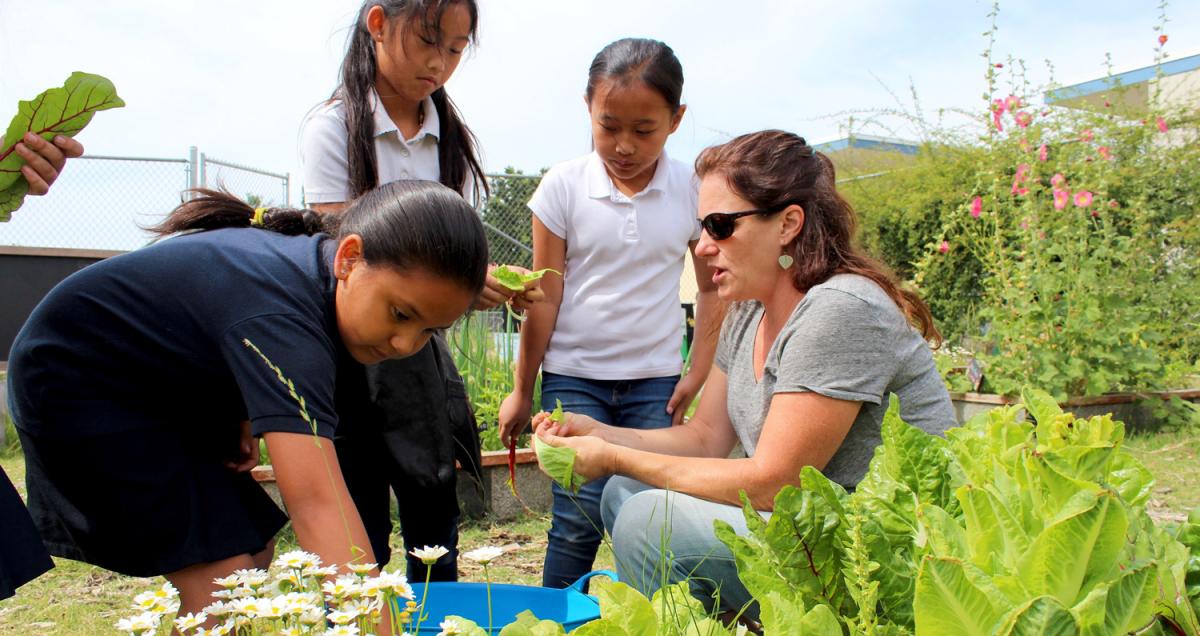
The small but mighty 2021 Food and Ag Cap-to-Cap Team is back prepping for the Metro Chamber’s annual regional advocacy program, which will be held virtually during the last week of October. As America’s Farm-to-Fork Capital, the Team strives to elevate the importance of the $12 billion+ food and agriculture economic cluster, highlighting innovations and initiatives across our food system, and leveraging federal policies, programs and investments.
After the Spring 2020 Cap-to-Cap visit was postponed last year due to the COVID-19 pandemic, the team continued to work with regional, state and federal partners on issues that have even more urgency than before – strengthening the resiliency of the regional food system, and ensuring a strong workforce. Our third big issue – broadband connectivity, access and adoption, which focused on supporting our rural economies and driving adoption of agri-food technologies – has broadened to a high overall regional priority, given all the impacts from the pandemic. We’re grateful to the Cap-to-Cap Economic Development Team for taking on this issue, linking to it as one of the region’s key infrastructure strategies.
To strengthen the region’s resilience, one Cap-to-Cap priority is to target institutional procurement policy changes that will expand local purchasing and supply chains and support local growers, food processors, distributors, and more. We are seeking increased flexibility in the USDA National School Lunch Program’s procurement regulations so local school districts can receive Cash in Lieu of Commodities – meaning school districts can use funds to purchase local goods instead of having to obtain food products from outside the state. This is a true Farm-to-School approach. As we have for many years, we continue to support the development of food system infrastructure such as food hubs, central kitchens at schools, and other facilities and equipment to increase opportunities for farm-to-institution procurement, including for hospitals. We have excellent examples of local procurement initiatives such as with Sacramento City Unified School District’s Nutrition Services and UC Davis Health system that have greatly expanded local purchasing, supporting the local economy and also delivering more than 65,000 fresh and healthy meals daily prepared by our local chefs. We also have a goal to address SNAP eligibility requirements for food insecure college students across the region.
Our other Cap-to-Cap priority is supporting the food and ag cluster’s workforce. Pre-COVID, there was already a skills gap and a pipeline gap across the economic cluster. With the average farmer being 57.5 years of years of age and the average skilled manufacturing (food processing) worker being 55 years of age, we now face a new challenge of worker retention, along with increased demand for digital and agri-tech skills across the entire industry. And of course, we want to ensure that our farmworkers and other front-line workers who kept the regional food system and supply chain going – through health crises and climate challenges, to ensure safe and healthy food for all of us – have safe working conditions and opportunities for income mobility. The Team supports increased federal investments in the Workforce Innovation and Opportunity Act, including for training, industry partnerships, and apprenticeships among others, to reskill, upskill, retain, recruit and grow the next generation of farmers, food entrepreneurs and food system workers. We also support legislation to provides certified agricultural workers with a path to help achieve earned legal status.
The Cap to Cap team is led by Honey Agency, Sacramento City Unified School District Nutrition Services, Valley Vision and Wilson Vineyards. Valley Vision is excited that this year’s program also will benefit from the update of the Food System Action Plan from 2015, prepared in partnership with the Sacramento Region Community Foundation, and the new Food System Resilience Poll, conducted in partnership with Sacramento State Institute for Social Research. These linked reports will be released in early October, giving us new insights for our food system. It will help drive the success of our Greater Sacramento Region Prosperity Strategy, in which food and agriculture is one of our three competitive advantage clusters. We’re also excited that Cap-to-Cap will provide the opportunity to work with our supportive Congressional delegation and new leaders at USDA and other agencies who hail from the region. Please join us to lend your voice and expertise to our food and ag mission!
To continue staying up to date with efforts to strengthen our regional food system, subscribe to Valley Vision’s Food for Thought email newsletter!
Trish Kelly is Valley Vision’s Managing Director, leading its food, agriculture, workforce, and broadband initiatives.